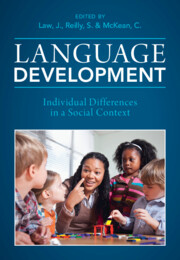Book contents
- Language Development
- Language Development
- Copyright page
- Contents
- Figures
- Tables
- Contributors
- A Tribute to Our Friend, Colleague and Fellow Editor, Professor James Law
- Introduction
- Part One Factors Influencing Language Development
- Part Two Continuity and Change
- Part Three Impact, Intervention and Equity
- 15 Communication, Participation and Cohort Studies
- 16 Capturing the Voice of Parents and Children
- 17 Oral Language Skills as a Foundation for Learning to Learn
- 18 The Economic Impact of Low Language Ability in Childhood
- 19 A Review of Interventions to Promote Language Development in Early Childhood
- 20 Interventions to Promote Language Development in Typical and Atypical Populations
- 21 The Effect of Kindergarten Instructional Policies on Reading and Math Achievement Gaps
- 22 Educational Interventions Targeting Language Development
- 23 Equity and Access to Services for Children with Language Difficulties
- Index
- References
20 - Interventions to Promote Language Development in Typical and Atypical Populations
from Part Three - Impact, Intervention and Equity
Published online by Cambridge University Press: 11 August 2022
- Language Development
- Language Development
- Copyright page
- Contents
- Figures
- Tables
- Contributors
- A Tribute to Our Friend, Colleague and Fellow Editor, Professor James Law
- Introduction
- Part One Factors Influencing Language Development
- Part Two Continuity and Change
- Part Three Impact, Intervention and Equity
- 15 Communication, Participation and Cohort Studies
- 16 Capturing the Voice of Parents and Children
- 17 Oral Language Skills as a Foundation for Learning to Learn
- 18 The Economic Impact of Low Language Ability in Childhood
- 19 A Review of Interventions to Promote Language Development in Early Childhood
- 20 Interventions to Promote Language Development in Typical and Atypical Populations
- 21 The Effect of Kindergarten Instructional Policies on Reading and Math Achievement Gaps
- 22 Educational Interventions Targeting Language Development
- 23 Equity and Access to Services for Children with Language Difficulties
- Index
- References
Summary
Although language development in children follows a predictable pattern and rate, it is common for interventions to be proposed to increase language skills especially when children are seen to be functioning behind their peers. The key argument is that environmental modifications have the potential to change language trajectories. These can be delivered at a universal level (for everyone) at a targeted-selected level (for groups perceived to be in need,) at a targeted-indicated level for those with an identified need, and at a specialist level (for those with the most pronounced difficulties). In this chapter we focus on two recent overviews of randomised controlled trials, one on parent–child book reading and a second on interventions delivered by professionals to promote language development. It focuses on the collective outcomes of these interventions rather than the details of the interventions themselves. The results suggest that, in the short term at least, there are reasonably consistent positive findings across a range of different interventions, although the effects vary considerably by outcome. It is not yet clear whether the downstream effects of such interventions are sustained or indeed whether children are able to catch up with their peers.
Keywords
- Type
- Chapter
- Information
- Language DevelopmentIndividual Differences in a Social Context, pp. 470 - 494Publisher: Cambridge University PressPrint publication year: 2022
References
- 2
- Cited by



